Accepted Scientific Name: Haworthia herbacea (Mill.) Stearn
Cact. Succ. J. Gr. Brit. 7: 40 1938.

Haworthia papillosa Photo by: Valentino Vallicelli
Origin and Habitat: Without locality, cultivated plants.
Synonyms:
See all synonyms of Haworthia herbacea
Description: Haworthia papillosaSN|17067]]SN|17067]] is a small, low growing succulent that forms crowded clusters of rosettes with characteristic raised dots on both sides of the leaves. It is one of the Haworthia with the prettiest foliage. It was introduced into cultivation about 1750.
Leaves: Erect, incurved, ovate-lanceolate or triangular, multifarious, thick, pointed and quite stiff, up to 6(-10) cm long and about 1-3 cm broad at the base, glaucous green or dull-green often reddish-brown in strong light and under stress, rather convex on the face, rounded on the back, obscurely keeled towards the apex, covered with raised pearly bosses 2 mm in diameter randomly speckled on both sides of the leaves.
Inflorescence: Flowering stalk simple or branched 30-40 cm tall wit the racemes 15-22 cm long. Pedicels short, erecto-patent; bracts minute, deltoid; perianth about 2 cm long; limb half as long as the tube.
Flowers: Large, creamy-white or beige with pinkish (or greenish) tips.
Blooming season: It flowers mainly in late spring to summer.
Subspecies, varieties, forms and cultivars of plants belonging to the Haworthia herbacea group
- Haworthia herbacea (Mill.) Stearn: var. herbacea has greenish-yellow reticulate leaves with translucent areas, margins and keel with firm spines. Distribution: Western Cape (Worcester-Robertson Karoo)
- Haworthia herbacea var. flaccida M.B.Bayer: has smaller delicate rosettes. Distribution: Western Cape (Worcester-Robertson Karoo)
- Haworthia herbacea var. lupula M.B.Bayer: has broader and shorter leaves, that are less rough-textured and finely flecked. Flowers pink. Distribution: Western Cape (Worcester-Robertson Karoo)
- Haworthia herbacea var. paynei (Poelln.) M.B.Bayer: has smaller rosettes. Flowers pink above and white below. Distribution: Western Cape (Worcester-Robertson Karoo)
 Haworthia papillosa Haw.: has raised pearly dots about 2 mm in diameter randomly speckled on both sides of the leaves. Distribution: Without locality, cultivated plants.
Haworthia papillosa Haw.: has raised pearly dots about 2 mm in diameter randomly speckled on both sides of the leaves. Distribution: Without locality, cultivated plants.
Bibliography: Major references and further lectures
1) J.G. Backer “Flora Capensis” page 253 (1897)
2) Haworth, Adrian Hardy. 1819. Original description of Haworthia papillosa.
3) Urs Eggli “Illustrated Handbook of Succulent Plants: Monocotyledons” Springer, 2001
4) Charles L. Scott “The genus Haworthia (Liliaceae): a taxonomic revision” Aloe Books, 1985
5) James Cullen, Sabina G. Knees, H. Suzanne Cubey “The European Garden Flora Flowering Plants: A Manual for the Identification of Plants Cultivated in Europe, Both Out-of-Doors and Under Glass” Cambridge University Press, 11/Aug/2011
6) M. B. Bayer “The new Haworthia handbook” National Botanic Gardens of South Africa, 1982
7) John Pilbeam “Haworthia and Astroloba: A Collector's Guide” B. T. Batsford Limited, 1983
8) Gordon D. Rowley “The illustrated encyclopedia of succulents” Crown Publishers, 01/Aug/1978
 Haworthia papillosa Photo by: Valentino Vallicelli
Haworthia papillosa Photo by: Valentino Vallicelli Haworthia papillosa Photo by: Valentino Vallicelli
Haworthia papillosa Photo by: Valentino Vallicelli Haworthia papillosa Photo by: Valentino Vallicelli
Haworthia papillosa Photo by: Valentino Vallicelli Haworthia papillosa Photo by: Giuseppe Distefano
Haworthia papillosa Photo by: Giuseppe DistefanoCultivation and Propagation: Haworthia are of easy cultivation and relatively low maintenance (they can grow easily on window sills, verandas and in miniature succulent gardens where they are happy to share their habitat with other smaller succulent plants, or in outdoor rockeries). Haworthias are winter growers and are dormant in the hottest summer months.
Growth rate: They are relatively fast-growing plants that offsets freely to form small clusters quickly.
Soil: They are tolerant of a wide range of soils and habitats, but prefer a very porous potting mix to increase drainage. A non-acid soil is ideal. You can grow a plant in a 10-15 cm pot for years and have perfectly happy plants. For best results, use a shallow pot.
Exposition: The plant needs light shade to shade, but will take full sun part of the day. (with some sun exposure the leaf develops a nice reddish tint and remains compact)
Watering: During the hot summer months, the soil should be kept moist but not overly wet. During the winter months, water only when the soil becomes completely dry. Wet soil quickly causes root and stem rot, especially during chilly winter months. . No water should ever be allowed to stand around the roots. Low ambient humidity is always needed.
Fertilization: The plants are fertilized only once during the growing season with a balanced fertilizer diluted to ½ the recommended strength.
Hardiness: Although the plant will survive mild frost if kept dry (hardy as low as -5° C) it should be protected from severe cold and prolonged frost conditions.
Rot: Rot is only a minor problem with Haworthia if the plants are watered and “aired” correctly. If they are not, fungicides won't help all that much. Care must be given in watering, keeping them warm and wet while growing, and cooler and dry when dormant.
Remarks: Haworthias are best planted in a shaded and airy part of the greenhouse, and not too close to the glass roof or sides of the house as the plants can overheat during hot spells.
Propagation: Haworthia are easily propagated by the removal of offshoots or by leaf cuttings in spring or summer. To propagate by leaf cuttings, remove a leaf and let it lie for about one month, giving the wound time to heal. Then lay the leaf on its side with the basal part buried in the soil. This leaf should root within a month or two, and small plants will form at the leaf base. They can also be grown from seed.














